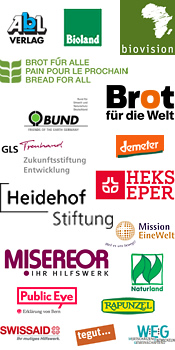Nachricht
12.11.2021 | permalink
Poor countries are faced with high food import bills, warns FAO

Rising food and energy prices pose significant challenges for poorer countries and consumers, who spend large shares of their incomes on these basic necessities, warns a new UN report. According to the “Food Outlook”, a report published twice a year by the Food and Agriculture Organization (FAO), global food trade has not only continued to expand in value and volume, but growth has even accelerated, says the report released on November 11th. The FAO experts forecast that the world food import bill will reach a record high in 2021, surpassing USD 1.75 trillion. This would represent a 14% increase from 2020 and is 12% higher than the estimates presented in the last Food Outlook released in June. The increase is mainly driven by higher price levels of internationally traded food commodities and a threefold increase in freight costs. On November 4th, FAO had already sounded the alarm that world food prices surged to a new peak, reaching their highest level since July 2011. The Food Price Index which measures monthly changes in international prices of a basket of food commodities (cereals, oilseeds, dairy products, meat and sugar), averaged 133.2 points in October 2021, up 3% from September. The prices rose for a third consecutive month, primarily led by continued strength in the world prices of vegetable oils and cereals.
Developing regions account for 40% of the total world food import bill of 1.75 trillion US Dollars expected for 2021. Their aggregate food import bill is expected to rise by nearly 20% compared to last year. The Least Developed Countries (LDCs) could see their food import bill rise by 16%. “Low-Income Food-Deficit Countries (LIFDCs) are expected to experience even faster growth, with rates in excess of 20 percent compared with 2020,” says the report. However, this is not due to the fact that they import more but due to higher costs. For instance, of the additional imports of USD 25 billion by LIFDCs, more than USD 14 billion are due to higher prices and freights, whereas only USD 11 billion reflect higher volumes. Imports of staple foodstuffs are driving the record bills for developing regions. The report also points to a growing number of countries where households spend more than 60% of their income on necessities such as food, fuel, water and housing. Even at the rather low food and fuel prices of 2017, 30 countries spent 60% or more of their income on these necessities. Preliminary estimates for 2021 suggest that another 23 countries have joined this group and that the average expenditure shares in these 53 countries have risen from 62% in 2017 to 69% in 2021. “For many consumers, this may mean either lower quantities or qualities of food consumption, and hence hunger and malnutrition, or less money for other necessities such as health or the schooling of their children,” the authors warn. “Curtailing such important expenditures could send communities into a vicious cycle of deepening food insecurity and poverty, with potentially irreversible effects.”
The report also reviews market supply and demand trends for the world’s major foodstuffs, including cereals, vegetable oils, sugar, meat and dairy and fish. The world cereal production is forecast to increase to 2.79 billion tonnes in 2021, up from 2.77 billion tonnes in 2020. Record harvests are expected in 2021 for maize and rice. Cereal utilization for human consumption and animal feed is forecast to grow faster than production. Cereal utilization is expected to reach 2.81 billion tonnes, up from 2.76 in the previous year, which will lead to decreasing stocks. World meat production in 2021 is forecast to expand by 4.2% from 2020 and approach 353 million tonnes. This is principally based on “expectations of a strong output rebound in Asia and notable expansions in all major producing regions, except Oceania”, says the report. According to the authors, the bulk of the anticipated increase in Asia is foreseen in China, where meat output is likely to rise by 16% year-on-year to 90 million tonnes, mainly due to increases in pig meat production following price declines and recent African swine fever outbreaks in some provinces. Global milk production in 2021 is also forecast to expand, with anticipated increases in all major producing regions, led by Asia and North America.
The report also includes a special chapter on agricultural input prices. The FAO experts constructed a Global Input Price Index (GIPI) to illustrate the impacts of rapidly rising input prices, especially those of energy derived from fossil fuels, on food prices, and the likely consequences for global food security. The index, which is based on energy, fertilizer, pesticide, feed and seed prices as well as the FAO Food Price Index, shows that both prices have moved in a synchronous manner since 2005, indicating that higher input costs translate into higher food prices. In the year to August 2021, the Food Price Index rose by 34% and the GIPI increased overall by 25%, compared to the same period in 2020. But there are large regional and sector-specific differences within agriculture. The authors point out that soybean producers, for example, face lower needs of currently expensive nitrogen fertilizer, so they can benefit from higher product prices. Pig producers, on the other hand, have high feed costs and face low meat prices. High input prices are a problem for countries that depend on imports. Sub-Saharan Africa, for example, is among the most import-dependent regions in the world for phosphorous and nitrogen, with dependency rates for both at around 70%. The price of nitrogen is principally driven by fossil fuels, in the form of gas, and with the region being also heavily dependent on imported energy, this could all lead to higher food production costs and food inflation. (ab)

